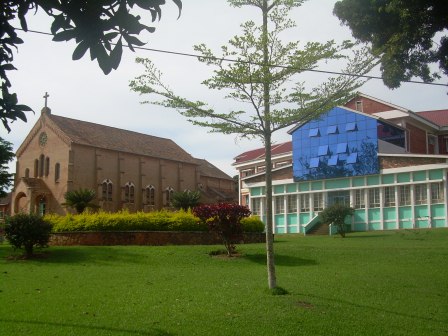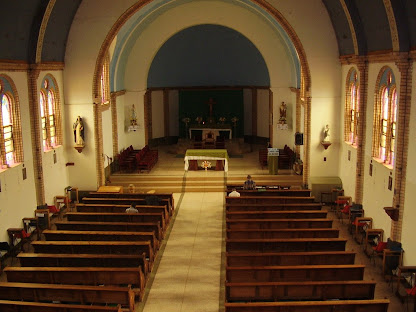Blogged with the Flock Browser
Monday, November 26, 2012
Wednesday, November 21, 2012
http://www.graduates.com/s
Over 1 million members have already joined. What are you waiting for?
Not sure? Take a tour. s.aspx?id=283356

Find your old classmates.
- What do they look like now?
- Are they married with kids?
- Are they looking for you?
Over 1 million members have already joined. What are you waiting for?
Not sure? Take a tour. s.aspx?id=283356
|
|
Katigondo National Major SeminaryMasaka - Uganda
If you think there are duplicate listings for this school, please:
use the school duplicate removal wizard |
||
| Help About Privacy Browse Schools Link to Us Chat Message Board Sign up |
KATIGONDO AT 100 YEARS
Katigondo National Seminary is in its 102nd year of existence but, according to Rev Father Dr Herman Kituuma, the rector of the seminary, the centenary celebrations will be held in 2013. It sounds a little strange that the centenary activities were not held in 2011, exactly 100 years after the seminary was established at its present location in what is today Kalungu District (in Masaka Diocese).
But this becomes easy to understand when it is remembered that the history of Katigondo Seminary actually forms a very important part of the history of the Roman Catholic Church. Not only here in Uganda but also in the entire East African region and Africa. It is the institution that turned out the first two African Roman Catholic priests in Sub-Saharan Africa, Father Basil Lumu and Father Victor Mukasa, and it is the institution that produced the first African bishop, Dr Joseph Kiwanuka.According to the book, A History of African Priests by John Mary Waliggo, the seminary was the first institution of higher learning in the region to provide the same quality of education to Africans as that offered in the European major seminaries and universities. Many of the teachers at the seminary were indeed referred to as professors. They taught Philosophy, Theology, Canon Law, Rhetoric, Mathematics, Politeness, Church History and a whole range of other disciplines and the languages of instruction were English and Latin.Today it takes at least eight years of studying after secondary school to be ordained a Roman Catholic Priest but even back then the priests’ training was not really any shorter. The training in the major seminary took 10 years, according to Waliggo. “Even if someone joins us today, and he already has a university degree, he still will undergo eight years of training,” Father Kituuma told this newspaper.It is indicated in Waliggo’s book: “On Sept 14, 1909 a decision was reached to separate the two seminaries and move the major to the opposite hill. Bukalasa had become rather too small and the number of major seminarians was increasing. Besides, Pope Pius X had expressed a wish that everywhere the major seminaries should be separated from the minor. Father Franco was therefore requested to start the supervision of the construction of the new buildings at Katigondo.”Katigondo was established by the White Fathers as a major seminary to take on young men who had finished their preliminary priesthood training in minor seminaries that already existed at places like Rubaga (in Kampala), Kisubi (Entebbe Road) and Bukalasa (in Masaka Diocese, some 400 meters from Katigondo).Father Franco became Katigondo Major Seminary’s first Rector and he moved there with 14 seminarians. Some of those seminarians, like Basil Lumu and Victor Womeraka Mukasa, had already advanced in their major seminary studies before leaving Bukalasa and within just three years of their stay at Katigondo, they were ready for ordination in 1913.Katigondo Major Seminary was officially opened on the Feast Day of St Thomas Aquinas, March 7, 1911, the saint to whom it is devoted. Just after gaining entrance into the seminary’s compound one’s attention is immediately drawn to an imposing statue of St Thomas Aquinas right in front of the chapel.Since then, according to Father Nnaku, some 4,000 seminarians have studied in Katigondo of whom 1,700 have been ordained priests and 27 consecrated bishops.Some of the buildings built around that time, like the Fathers’ residence, still stand to this day according to Rev Father Francis Nnaku, the dean of studies at Katigondo. He said the building whose walls were constructed with mud and red bricks was grass thatched in those days but after some years, it underwent some face lifting and got its present roof of clay tiles.Father Kituuma has an explanation for this. “The seminary has always been required to be self-reliant with regard to feeding its teaching staff and its students as well as meeting all its other financial obligations,” he offers. “In the past the seminarians did not pay tuition fees but nowadays because of reduced financial support from Rome and other sources, the seminarians are required to contribute some money for tuition and we have to work hard to generate money to sustain the institution.”If at most Catholic parishes in the country good farming practices are emphasised, it could have stemmed from the training the priests underwent at the seminary. Katigondo has a 500-acre farm on which the priests and seminarians grow different crops, keep poultry, and rear pigs, goats, and cows.Almost like in a monastery, the seminarians live a life of prayer, manual work, studying, and silence. The discipline is so strict that sometimes the seminarians may go to the fields to work in groups but may be forbidden to talk to one another during all the time they are working.So the seminary has tractors to cultivate some 300 acres of land for growing crops like sweet potatoes, beans, maize, bananas, coffee and a variety of fruits.Failure to observe such simple regulations could lead to serious disciplinary action or even dismissal from the seminary. Since it is a house of formation the number of seminarians has always been kept small, which means that the Fathers have more chance to observe them and to focus more on their training. Even today given the seminary’s enormous resources, compared to other Ugandan institutions, Katigondo has only about 240 students.
Friday, November 9, 2012
KATIGONDO NATIONAL MAJOR SEMINARY (St. Thomas Aquinas)
P. O Box 232, MASAKA
Tel. 0481-20094/077-221598
Email: katigond@africaonline.co.ug
P. O Box 232, MASAKA
Tel. 0481-20094/077-221598
Email: katigond@africaonline.co.ug
Subscribe to:
Comments (Atom)

